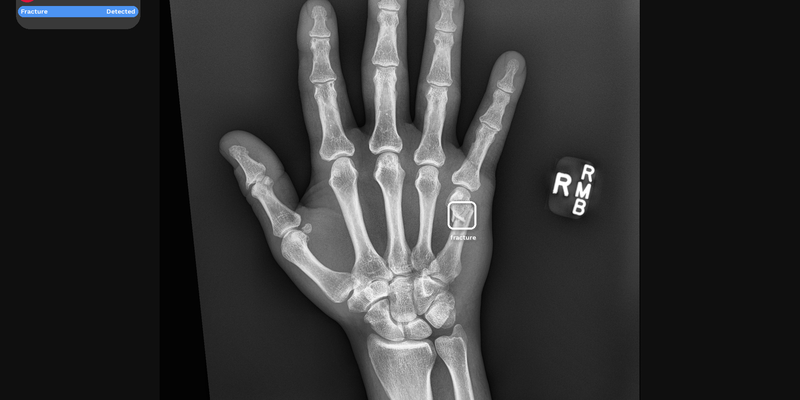
This Danish retrospective study is the first study on the AI tool RBfracture™ (Radiobotics) for detecting traumatic fractures on radiographs. The study involved 334 radiographic exams of participants aged 2 years and older, including 164 cases of obvious and nonobvious traumatic extremity fractures. Fifteen non-expert readers (e.g., advanced trauma care nurses, diagnostic radiographers) from different hospitals participated. The AI tool was used to assist these readers in two sessions, with and without AI support, to assess its impact on diagnostic performance. The AI assistance led to an increase in per-patient sensitivity from 72% to 80% and per-patient specificity from 81% to 85%, resulting in a 29% reduction in missed fractures. The rate of false positives per patient decreased from 0.16 to 0.14 (21% reduction). The largest gain was seen in non-obvious fractures (e.g., non-displaced or multiple fractures) with a sensitivity increase from 60% to 71%. There was no significant difference in average reading time per exam.
Read full study
Improving traumatic fracture detection on radiographs with artificial intelligence support: a multi-reader study
British Journal of Radiology (BJR Open), 2024
Abstract
Objectives
The aim of this study was to evaluate the diagnostic performance of nonspecialist readers with and without the use of an artificial intelligence (AI) support tool to detect traumatic fractures on radiographs of the appendicular skeleton.
Methods
The design was a retrospective, fully crossed multi-reader, multi-case study on a balanced dataset of patients (≥2 years of age) with an AI tool as a diagnostic intervention. Fifteen readers assessed 340 radiographic exams, with and without the AI tool in 2 different sessions and the time spent was automatically recorded. Reference standard was established by 3 consultant radiologists. Sensitivity, specificity, and false positives per patient were calculated.
Results
Patient-wise sensitivity increased from 72% to 80% (P < .05) and patient-wise specificity increased from 81% to 85% (P < .05) in exams aided by the AI tool compared to the unaided exams. The increase in sensitivity resulted in a relative reduction of missed fractures of 29%. The average rate of false positives per patient decreased from 0.16 to 0.14, corresponding to a relative reduction of 21%. There was no significant difference in average reading time spent per exam. The largest gain in fracture detection performance, with AI support, across all readers, was on nonobvious fractures with a significant increase in sensitivity of 11 percentage points (pp) (60%-71%).
Conclusions
The diagnostic performance for detection of traumatic fractures on radiographs of the appendicular skeleton improved among nonspecialist readers tested AI fracture detection support tool showed an overall reader improvement in sensitivity and specificity when supported by an AI tool. Improvement was seen in both sensitivity and specificity without negatively affecting the interpretation time.
Advances in knowledge
The division and analysis of obvious and nonobvious fractures are novel in AI reader comparison studies like this.